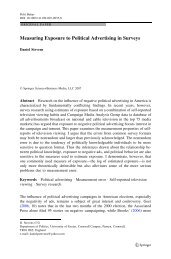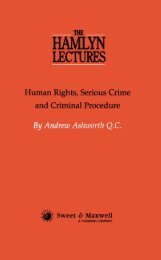Blackstone's Tower: The English Law School - College of Social ...
Blackstone's Tower: The English Law School - College of Social ...
Blackstone's Tower: The English Law School - College of Social ...
You also want an ePaper? Increase the reach of your titles
YUMPU automatically turns print PDFs into web optimized ePapers that Google loves.
What are <strong>Law</strong> <strong>School</strong>s for?<br />
<strong>of</strong> legal education and training in England and Wales since<br />
Ormrod, 24 it was becoming increasingly apparent that the legal pr<strong>of</strong>ession<br />
would only be able to absorb a relatively small proportion<br />
<strong>of</strong> those aspiring to practice, or at least to qualify, perhaps as few<br />
as a third. At the same time law was being given an increasingly<br />
high pr<strong>of</strong>ile in the media, in popular culture and on the international<br />
scene. While there was increasing talk <strong>of</strong> "overproduction"<br />
<strong>of</strong> law graduates, talk which assumed that the main function <strong>of</strong><br />
undergraduate law degrees was to prepare people for the pr<strong>of</strong>ession,<br />
there was also talk <strong>of</strong> the need for more continuing education,<br />
specialist training, judicial studies, parapr<strong>of</strong>essional training,<br />
human rights education and legal literacy. <strong>The</strong> market for legal<br />
educational services was expanding in some directions while contracting<br />
in others. University law schools had only been one kind<br />
<strong>of</strong> institution among several that provided legal education and it<br />
was only in the late nineteen-eighties that they had begun to move<br />
away from their self-image as being essentially providers <strong>of</strong> undergraduate<br />
and other forms <strong>of</strong> primary legal education. Questions<br />
therefore arose about the future shape and scale <strong>of</strong> the national<br />
system <strong>of</strong> legal education provision and the role <strong>of</strong> university law<br />
schools within it.<br />
In 1994 it seemed that the range <strong>of</strong> strategic possibilities was<br />
quite limited. 25 It was going to be difficult to break out <strong>of</strong> the<br />
Ormrod structure. On the one hand, the clinical medical school<br />
model, the postgraduate pr<strong>of</strong>essional school, the five-year undergraduate<br />
programme and other expensive options could be ruled<br />
out as not being feasible within a system which was still largely<br />
dependent on public finance, at least at the primary stage. On the<br />
other hand, it seemed equally unlikely that <strong>English</strong> universities<br />
would move directly to a mass system involving open entry and<br />
very large first year classes. Although there was a strong trend<br />
towards eroding the legal pr<strong>of</strong>ession's monopolies on some legal<br />
services, the tendency was to make entry to the legal pr<strong>of</strong>ession<br />
more competitive and pr<strong>of</strong>essional training more rigorous. It was<br />
extremely unlikely that there were would be a return to nongraduate<br />
entry on a large scale, but it was also improbable that a<br />
law degree as such would be required for entry to the pr<strong>of</strong>ession. 26<br />
It also seemed unlikely that law schools would be content with<br />
being little more than nursery schools for the pr<strong>of</strong>ession, contracting<br />
in size and accepting such a limited role.<br />
This left three main possibilities for <strong>English</strong> university law<br />
schools:<br />
56

















